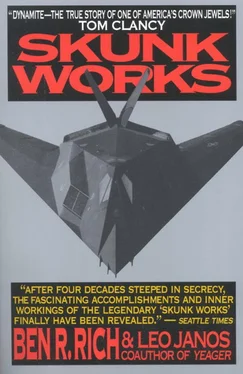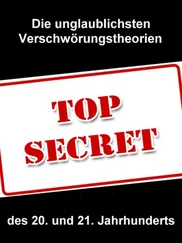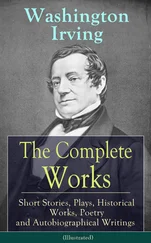Several of our aerodynamics experts, including Dick Cantrell, seriously thought that maybe we would do better trying to build an actual flying saucer. The shape itself was the ultimate in low observability. The problem was finding ways to make a saucer fly. Unlike our plates, it would have to be rotated and spun. But how? The Martians wouldn’t tell us.
During those early months of the Hopeless Diamond, I dug in my heels. I forced our in-house doubters to sit down with Denys and receive a crash course on Stealth 101. That helped to improve their confidence quotient somewhat, and although I acted as square-shouldered as Harry Truman challenging the Republican Congress, deep down I was suffering bouts of angst myself, wondering if Kelly and some of the other skeptics had it right while I was being delusional. I kept telling myself that the financial and personal risks in pursuing this project were minimal compared to its enormous military and financial potential. But the politics of the situation had me worried: stealth would have been a perfect third project for me, after two reassuring successes under my belt.
But if stealth failed, I could hear several of my corporate bosses grousing: “What’s with Rich? Is he some sort of flake? Kelly would never have undertaken such a dubious project. We need to take charge of that damned Skunk Works and make it practical and profitable again.”
Kelly Johnson would never double-cross me by bad-mouthing the stealth project in the corridors of the Skunk Works, but all of us knew Kelly too well not to be able to read his mood and mind. If he didn’t like something or someone, it was as obvious as a purple pimple on the tip of his nose. So I had him in for lunch and said, “Look, Kelly, I know you find this design aesthetically offensive, but I want you to do me one favor. Sit down with this guy, Overholser, and let him answer your questions about stealth. He’s convinced me that we are onto something enormously important. Kelly, this diamond is somewhere between ten thousand and one hundred thousand times lower in radar cross section than any U.S. military airplane or any new Russian MiG. Ten thousand to one hundred thousand times, Kelly. Think of it!”
Kelly remained unmoved. “Theoretical claptrap, Ben. I’ll bet you a quarter that our old D-21 drone has a lower cross section than that goddam diamond.”
We had a ten-foot wooden model of the diamond, and we took it and the original wooden model for the manta ray–shaped D-21 drone and put them side by side into an electromagnetic chamber and cranked up the juice.
That date was September 14, 1975, a date etched forever in my memory because it was about the only time I ever won a quarter from Kelly Johnson. I had lost about ten bucks’ worth of quarters to him over the years betting on technical matters. Like me, my colleagues collected quarters from Kelly just about as often as they beat him at arm wrestling. He had been a hod carrier as a kid and had arms like ship’s cables. He once sprained the wrist of one of our test pilots so badly he put the poor guy out of action for a month. So winning a quarter was a very big deal, in some ways even more satisfying than winning the Irish Sweepstakes. (Depending on the size of the purse, of course.)
I really wanted a photographer around for historical purposes to capture the expression on Kelly’s big, brooding moon-shaped mug when I showed him the electromagnetic chamber results. Hopeless Diamond was exactly as Denys had predicted: a thousand times stealthier than the twelve-year-old drone. The fact that the test results matched Denys’s computer calculations was the first proof that we actually knew what in hell we were doing. Still, Kelly reacted about as graciously as a cop realizing he had collared the wrong suspect. He grudgingly flipped me the quarter and said, “Don’t spend it until you see the damned thing fly.”
But then he sent for Denys Overholser and grilled the poor guy past the point of well-done on the whys and hows of stealth technology. He told me later that he was surprised to learn that with flat surfaces the amount of radar energy returning to the sender is independent of the target’s size. A small airplane, a bomber, an aircraft carrier, all with the same shape, will have identical radar cross sections. “By God, I never would have believed that,” he confessed. I had the feeling that maybe he still didn’t.
Our next big hurdle was to test a ten-foot wooden model of the Hopeless Diamond on an outdoor radar test range near Palmdale, on the Mojave desert. The range belonged to McDonnell Douglas, which was like Buick borrowing Ford’s test track to road test an advanced new sports car design, but I had no choice since Lockheed didn’t own a radar range. Our model was mounted on a 12-foot-high pole, and the radar dish zeroed in from about 1,500 feet away. I was standing next to the radar operator in the control room. “Mr. Rich, please check on your model. It must’ve fallen off the pole,” he said. I looked. “You’re nuts,” I replied. “The model is up there.” Just then a black bird landed right on top of the Hopeless Diamond. The radar operator smiled and nodded. “Right, I’ve got it now.” I wasn’t about to tell him he was zapping a crow. His radar wasn’t picking up our model at all.
For the first time, I felt reassured that we had caught the perfect wave at the crest and were in for one terrifically exciting ride. I saw firsthand how invisible that diamond shape really was. So I crossed my fingers and said a silent prayer for success in the tests to follow.
Other Voices
Denys Overholser
In October 1975, Ben Rich informed me that we and Northrop had won the first phase of the competition and would now contest against each other’s designs in a high noon shoot-out at the Air Force’s radar test range in White Sands, New Mexico. The two companies were each given a million and a half dollars to refine the models and told to be ready to test in four months.
The government demanded competition on any project, but that Hopeless Diamond shape was tough to beat. We built the model out of wood, all flat panels, thirty-eight feet, painted black. And in March 1976 we hauled it by truck to New Mexico. The White Sands radar range was used to test unarmed nuclear warheads, and their radars were the most sensitive and powerful in the free world.
The tests lasted a month. I never did see the Northrop model because under the ground rules we tested separately, on different days. In the end we creamed them. Our diamond was ten times less visible than their model. We achieved the lowest radar cross sections ever measured. And the radar range test results precisely matched the predictions of our computer software. This meant we could now confidently predict radar cross section for any proposed shape, a unique capability at that point in time.
The range was as flat as a tabletop; the pole downrange was in a direct line with five different radar antenna dishes, each targeting a different series of frequencies. The model was mounted atop the pylon and then rotated in front of the radar beam. Well, two very funny things happened. The first day we placed our model on the pole, the pole registered many times brighter than the model. The technicians had a fit. They had thought their poles were invisible, but the trouble was nobody had ever built a model that was so low in radar signature to show them how wrong they really were. Their pole registered minus 20 decibels—okay as long as the model on top was greater than 20. But when the model was registering an unheard-of lower value, the pole intruded on the testing. An Air Force colonel confronted me in a fit of pique: “Well,” he snorted, “since you’re so damned clever, build us a new pole.” I thought, Oh, sure. Build a tower that’s ten decibels lower than the model. Lots of luck.
Читать дальше












